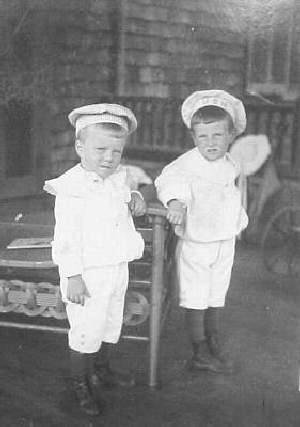
Figure 1.--These two America boys, probanly brothers, wear wahite sailor suits with flouncy white sailor caps. The snap shot was probably taken about 1905. |

|
Sailor caps were worn by boys in most European countries and America. Many different styles were worn in various countries. Some of the styles were similar if not identical, largely because the British Royal Navy was so influential in so many ways--including even uniforms. After Trafalgur (1805), no other navy even remotely approached the power of the Royal Navy. Most advances in naval matters during the 19th century were made by the British. (The American ironclads were virtually the only exception.) There is some country differences, however, because sailor cap styles tended to follow the styles worn by national navies and there were differences from country to country. We notice several different styles over time. The differences over time were much more important than those between different countries. We do not yet have a lot of country sailorcap images beyond those of the major countries such as America, Britain, France, Germany, and Italy.
The sailor suit developed as a major syle for boys in the late-19th century. It developed first in Britain and then spread to America. British styles were very influential in America, but sailt suits and caps became a standard for children throughout the Western world. There was sailor headwear worn with the suits. The most common headwear for younger boys in the late-19th century was the wide-brimmed sailor hat, but sailor caps soon became more popular. There were several different styles, primarily following the uniform caps worn by the U.S. Navy. Unfortunately we are not entirely sure about the proper name for these caps. Sailor caps were widely worn by boys and to some extent girls in the late-19th and early-20th century. Sailor caps were mostly done in blue or white. They were of coure worn with sailor suits. They were, however, also worn with many different garments. We note Harold Howes in 1905 wearing a sailor cap with a tunic suit. Boys might wear sailor suits with out the caps. The proper sailor caps were rather a formal style, often not worn casually. An exception was the swabie cap worn beinning in the 1920s.
Gradually English boys began wearing sailor caps as well. The initial inspiration was Royal Navy uniforms. The caps seem more diverse than the hats. I'm not sure hen boys begn wearing sailor caps. I think in the 1880s. There were many popular styles of sailor caps. The large number of sailor styles were in part due to the long period in which sailor fashions were popular for boys, about 100 years. There were sailor caps with flat tops, soft crowns, tams, stocking caps, and other styles. The styles usually followed the standard uniform styles of the Royal Navy, but some like tams were specifically for children. We note sailor cps almost always being orn with sailor suits. This sounds obvious, but in Europe we note sailor cps sometimes being wirn with non-sailor caps. Thid probably did not occur becaude the peaked school cap was so commonly worn during much of the erain which sailor caps were worn. Sailor caps were mostly worn by boys.
|
Popular styles of sailor caps followed the uniform styles of the Germany Navy. There were, however, a definite social class aspect to sailor suits and sailor headwear. They were especially popular with upper and middle-class families. We see German boys commonly wearing sailor caps by the 1890s. They surely were worn earlier, but we have few hisorical images. Boys wore a range of cap styles, but they seemed to have cloesly followed the styles of the German Kriegsmarine. There were different styles as well as both blue and white caps. Some were rather stiff construcrtion likethe saucer caps here (figure 1). I'm not sure what the proper term was for these caps. We have also seen soft caps. We see boys wearing sailor caps in the 1920s when sailor hats were no longer commonly worn. Sailor caps except as part of the Hitler Youth Marine Division virually disappeared in Germany after the NAZIs came to power. The NAZIs generally disapproved of sailor suit, except for very little pre-school boys.
Navigate the Historic Boys' Clothing Web Site:
[Return to the Main sailor cap page]
[Introduction]
[Activities]
[Biographies]
[Chronology]
[Clothing styles]
[Countries]
[Essay]
[Girls]
[Bibliographies]
[Contributions]
[FAQs]
[Glossaries]
[Links]
[Images]
[Links]
[Registration]
[Tools]
[Boys' Clothing Home]
